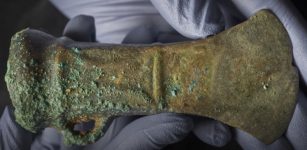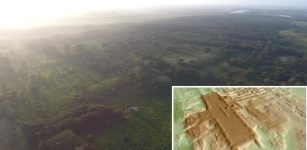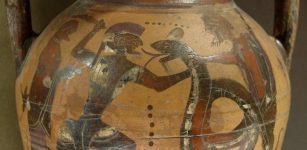The Inca Empire Was Powerful And Well-Organized – Why Were They So Successful?
A. Sutherland - AncientPages.com - The Inca state and culture were born with a legend.
The children of the god Inti, Manco Capac and his sister Mama Ocllo wandered from Lake Titicaca to the Cuzco Valley. The mission of civilization was given to them by their father, the sun god. After persuading local Indians to worship the sun, they taught them animal husbandry, house building, fieldwork, and various other crafts.

Pachacuti (Pachakutiq Inka Yupanki) established the Inca Empire after defeating the Chanca people, an indigenous group who lived in the Andes from the 10th to 14th centuries.
In 1438, the Chanca were attacking the Inca capital Cuzco and threatened to take it.
Another colorful legend says that at the crucial moment on the battle with the Chanca tribe, the stones in the battlefield turned temporarily into warriors and effectively helped Pachacuti’s forces to destroy the enemy. Later, the rocks were gathered and placed in shrines for future worship.
Pachacuti, the ninth Sapa Inca (1418–1471/1472), defeated the Chanca and made the Inca Empire powerful during his reign.
The year 1438 is considered the birth of the Inca Empire (in Quechua: 'Tawantinsuyu'), and Pachacuti earned him the title 'Transformer of the World' and 'Earthshaker.'
He was a very ambitious man, as can be seen from the areas he conquered. He rebuilt Cuzco and the great temple of the sun in the city after the battle with the Chanca. Cuzco became the political, administrative, and military center of the Inca Empire.
Pachacuti also developed the Inca state, organized the institutions, and introduced systems of tribute and taxation and tribute, which were paid by conquered peoples in the form of goods or labor. The next step was to build an extensive road network to connect towns, villages, and sites of worship. The roadways important for the well-functioning state, but it was not easy to build them in a mountainous country like Peru.

Keshwa Chaca - Suspension Rope Bridge. source
Pachacuti contributed with an effective imperial communication network and extensive warehousing of food and other commodities indispensable for redistribution throughout the Empire.
The Incan massive road system emanated from Cuzco to connect the four regions of the country. These roads were a wonder of engineering and included nearly 40,000 kilometers (25,000 miles) of connected roadways.
Tahuantinsuyu (means "The Four Regions Together”) developed rapidly during the reign of Pachacuti. With the cult of the sun in mind and heart, the Inca troops, loyal to the Cuzco rulers, conquered other tribes from present-day northern Ecuador, central Chile, south-central Bolivia, northwest Argentina, and from the coasts of the Pacific Ocean to the Amazon jungle.
The assimilation of these tribes was not always easy, and from 1438 to 1533, the Incas used many different methods, including conquest and peaceful assimilation, to incorporate the tribes into the Empire.
Assimilated artisans and skilled builders constructed new buildings, suspension bridges, roads, and terraces for agriculture in the conquered areas. In this way, they made a daily contribution to the power of the Inca state. The worship of the ancient Incan sun god, Inti, was imposed by Pachacuti, and Quechua became the unified language for the people who began to believe their rulers to be descendants of the sun god and learned to live under their unquestioned authority.
There was almost no crime in the Inca empire. The Inca laws were severe and punishment was harsh. Any kind of law transgression was considered an action against divinities and for the cursing of gods, people were often executed. If they were caught stealing, they would have their hands cut off.
There was no system of imprisonment and offenders were punished so that the penalty was exemplary to the rest of the population.
Historians often comment on the Inka’s exceptionally organizational skill in their country.
The scholar Lewis Hanke, a preeminent U.S. historian of colonial Latin America, who is best known for his writings on the Spanish conquest of Latin America, wrote that
“In everything from the most important to the most trifling, there was order and methodical arrangement,” wrote ……“ Men had honorable and useful occupations…lands, mines, pastures, hunting lands, woods, and all kinds of employments were so managed that each person knew and held his own state.”

Machu Picchu, Peru - rpbmedia - Adobe Stock
“In each district of the four in which they divided their Empire, the Inka had councils of war, justice, treasury. Each of these councils had their ministries and ministers and subordinates from major to minor...from decurions that handled ten to others who handled hundreds, thousands, and tens of thousands. From grade to grade, these levels gave a count of everything there was in the Empire to the supreme councils…”.
The territory of the Inca Empire was divided into three parts: the Lands of the Inca, the Lands of the Inti and other gods, and the Lands of the local families, all roads across the Empire led to Cusco. The roads ‘go from Quito to Chile, and into the forests of the Andes. Although the Inca did not complete all, suffice it that he made a great part of the roads, which were finished by his sons and grandsons.’ 1
At the height of its power between 1470 and 1532, the Inca Empire was inhabited by ten million people.
Written by – A. Sutherland - AncientPages.com Senior Staff Writer
Copyright © AncientPages.com All rights reserved. This material may not be published, broadcast, rewritten or redistributed in whole or part without the express written permission of AncientPages.com
Expand for referencesReferences:
de Gamboa, Pedro Sarmiento. History of the Incas
Ostler N. Empires of the Word
Ramiro Matos, Jose Barreiro, The Great Inka Road: Engineering an Empire
- Hanke L. History of Latin American Civilization Vol.1
More From Ancient Pages
-
 On This Day In History: Treaty Of Worms Signed Between Great Britain, Austria And The Kingdom Of Sardinia – On Sep 13, 1743
News | Sep 13, 2016
On This Day In History: Treaty Of Worms Signed Between Great Britain, Austria And The Kingdom Of Sardinia – On Sep 13, 1743
News | Sep 13, 2016 -
 Hadrian’s Wall: North-West Frontier Of The Roman Empire For Nearly 300 Years
Featured Stories | Sep 1, 2020
Hadrian’s Wall: North-West Frontier Of The Roman Empire For Nearly 300 Years
Featured Stories | Sep 1, 2020 -
 The Olympics In Ancient And Modern Times – What Has Changed?
Featured Stories | Jun 20, 2019
The Olympics In Ancient And Modern Times – What Has Changed?
Featured Stories | Jun 20, 2019 -
 Controversial Tartaria Tablets: The First Writing System In The World?
Artifacts | Nov 13, 2014
Controversial Tartaria Tablets: The First Writing System In The World?
Artifacts | Nov 13, 2014 -
 Hidden Silver Casket With Bones Of 13th Century Saint Found
Archaeology | Mar 22, 2020
Hidden Silver Casket With Bones Of 13th Century Saint Found
Archaeology | Mar 22, 2020 -
 Wooden Coffin With Greco-Roman Mummy Wearing Mask Depicting Sky God Discovered In Egypt
Archaeology | Nov 17, 2017
Wooden Coffin With Greco-Roman Mummy Wearing Mask Depicting Sky God Discovered In Egypt
Archaeology | Nov 17, 2017 -
 Sacred Bird Garuda And Stealing Of Amrita Drink Of Immortality From The Gods
Featured Stories | Jun 5, 2019
Sacred Bird Garuda And Stealing Of Amrita Drink Of Immortality From The Gods
Featured Stories | Jun 5, 2019 -
 Unique Knife That Belonged To Early Medieval Scribe Unearthed In Poland
Archaeology | Jan 22, 2018
Unique Knife That Belonged To Early Medieval Scribe Unearthed In Poland
Archaeology | Jan 22, 2018 -
 Machu Picchu Was Built With The Royal Unit System – New Research Suggests
Archaeology | Jan 14, 2021
Machu Picchu Was Built With The Royal Unit System – New Research Suggests
Archaeology | Jan 14, 2021 -
 Mysterious Havering Hoard – Largest Ever Bronze Age Hoard Discovered In London
Archaeology | Oct 21, 2019
Mysterious Havering Hoard – Largest Ever Bronze Age Hoard Discovered In London
Archaeology | Oct 21, 2019 -
 World’s Oldest And Largest Maya Structure Revealed By LIDAR
Archaeology | Jun 9, 2020
World’s Oldest And Largest Maya Structure Revealed By LIDAR
Archaeology | Jun 9, 2020 -
 Ancient Stepwells Of India: Symbol Of Sacred Water And Boundary Between Heaven And Earth
Civilizations | Jan 11, 2019
Ancient Stepwells Of India: Symbol Of Sacred Water And Boundary Between Heaven And Earth
Civilizations | Jan 11, 2019 -
 Inanna – Prominent And Highly Honored Mesopotamian Goddess
Featured Stories | May 31, 2021
Inanna – Prominent And Highly Honored Mesopotamian Goddess
Featured Stories | May 31, 2021 -
 Cadmus – Legendary Phoenician Hero And Founder Of Prosperous City Of Thebes
Featured Stories | Sep 6, 2023
Cadmus – Legendary Phoenician Hero And Founder Of Prosperous City Of Thebes
Featured Stories | Sep 6, 2023 -
 2,000-Year-Old Tumulus Of Unknown Culture Discovered In Siberia – Who Were These People?
Archaeology | Jan 4, 2023
2,000-Year-Old Tumulus Of Unknown Culture Discovered In Siberia – Who Were These People?
Archaeology | Jan 4, 2023 -
 Controversial Stone Statues Of Niulang And Zhinyu And The Legend Of The Heavenly Queen And Milky Way
Artifacts | Sep 8, 2017
Controversial Stone Statues Of Niulang And Zhinyu And The Legend Of The Heavenly Queen And Milky Way
Artifacts | Sep 8, 2017 -
 Gigantic Neolithic Newgrange Monument: A Temple, Astronomical Observatory Or Ancient Tomb?
Civilizations | Aug 14, 2016
Gigantic Neolithic Newgrange Monument: A Temple, Astronomical Observatory Or Ancient Tomb?
Civilizations | Aug 14, 2016 -
 7,000-Year-Old Male Skeleton In Garment Decorated With Sea Shells, Red Deer Teeth Identified In France
Archaeology | Mar 9, 2017
7,000-Year-Old Male Skeleton In Garment Decorated With Sea Shells, Red Deer Teeth Identified In France
Archaeology | Mar 9, 2017 -
 How Did Native American Indian Chiefs Get Their Names?
Ancient History Facts | May 27, 2016
How Did Native American Indian Chiefs Get Their Names?
Ancient History Facts | May 27, 2016 -
 Unique Ancient Three-Headed Eagle Pendant Discovered In Finland: A Symbol Of Three Different Human Souls
Ancient Symbols | May 6, 2016
Unique Ancient Three-Headed Eagle Pendant Discovered In Finland: A Symbol Of Three Different Human Souls
Ancient Symbols | May 6, 2016
